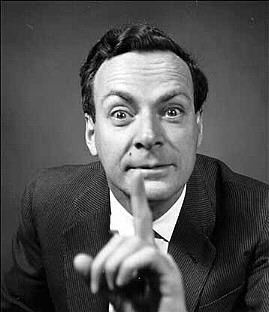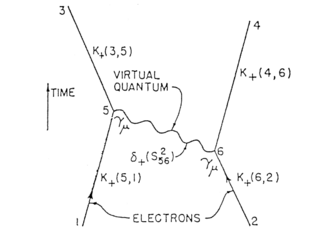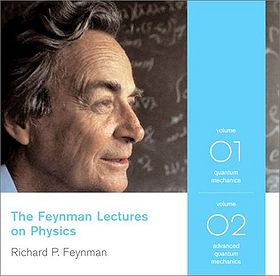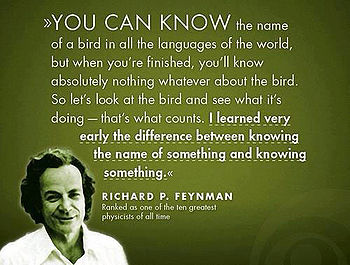Richard Phillips Feynman
Claimed and Written by Catherine Johnson, PHYS 2211 C04 Edited by Jennifer Vo, PHYS 2212 Q05
Richard Phillips Feynman, an American theoretical physicist, was quite famous for his work with quantum mechanics, electrodynamics, and superfluidity, but was most known for his familiarization with particle physics. He was granted a Nobel Peace Prize in 1965 for Physics.

Early Life
Feynman was born in New York City, New York, on May 11th, 1918, to Lucille and Melville Arthur Feynman. His parents originated from Poland and Russia, and both were Ashkenazi Jews, or "Germanic Jews". However, neither of his parents were very religious, and therefore, Richard proclaimed himself atheist as a young boy. Feynman could not talk until the age of three, but once he could, he closely retained his Bronx accent. As Feynman grew, his parents were greatly supportive of his creative mind-set. His father continuously pushed him to think beyond the box, and his mother provided him with a sense of humor that carried him happily through life. He became a little engineer all on his own, and by age 10, he created a home burglar alarm system while his parents were out. At age nine, Feynman gained a baby sister Joan, and the two became very close. Although Richard's mother disapproved of Joan's high level of curiosity for a woman, Richard always encouraged his little sister, and she later became an astrophysicist specializing in Earth's solar winds. Due to his family's constant support, Feynman developed a general curiosity about the world that led him to discover great things in the future.
Education
Feynman was always very dedicated to his school work. While attending Far Rockaway High School as a teenager, he taught himself many disciplines of mathematics that usually only collegiate students could perceive. He graduated from Far Rockaway in June of 1935, and was accepted and soon attended the Massachusetts Institute of Technology (MIT). He graduated from MIT with a BS degree in Physics in 1939, after realizing his initial passion with mathematics did not carry far enough into the world of application, in his opinion. He then followed his studies with quantum mechanics to Princeton University, and received his doctorate in physics in 1942. Feynman joined the Manhattan Project during World War II and was the head of the theoretical division. He later was appointed a professor at Cornell University, but he soon transferred to the California Institute of Technology in 1950 to further his research in quantum mechanics.
Scientific Contributions

Feynman contributed to modern science in various ways, upon which he earned the Nobel Peace Prize in Physics in 1965 "for their [Feynman's, Tomonaga's, and Schwinger's] fundamental work in quantum electrodynamics, with deep-ploughing consequences for the physics of elementary particles".
Following Feynman's successes in quantum mechanics, a relativistic theory was created for the interaction of charged particles with electromagnetic fields. However, in Feynman's attempt to reform the theory, he contributed to a new quantum electrodynamics (the theory of the interaction between light and matter). In 1948, he introduced his "Feynman diagrams", which were simple graphical representations to help conceptualize complex interactions between different particles in space-time. The goal for his diagrams was to use them to model the entirety of physics in terms of particles' spins and forces, to explain their interactions. Still today, these diagrams further allow calculations of the probabilities of many interactions.
In 1969, Feynman proposed the parton model, which was a way to analyze high-energy hadron collisions in particle physics. Within the model, a "hadron", which could, for example, be a proton, is composed of a number of "partons". The hadron theoretically has infinite momentum and very high energy. Therefore, parton motion is slowed by time dilation, the difference of elapsed time between two events. This causes the hadron charge distribution to be length-contracted, which forces incoming particles to be scattered instantaneously and randomly. This model was applied to the electron-proton deep inelastic scattering that Bjorken and Paschos created, which was a process used to probe the insides of hadrons. The parton model has now been developed and remains a justifiable estimation of reactions of particles at high energies.
Another of Feynman's most remarkable scientific contributions was The Feynman Lectures on Physics.
The Feynman Lectures on Physics

The Feynman Lectures on Physics is a physics textbook written by Richard P. Feynman himself, that was given to collegiate students at Cal Tech from 1961 to 1963. The book also had two other authors: Robert B. Leighton and Matthew Sands. The book is composed of three volumes, with the first focusing on heat, radiation, and mechanics; the second one exploring matter and electromagnetism; and the third volume discussing quantum mechanics. However, the book also includes several chapters focusing on relating physics to other subjects, including mathematics.
The lectures were initially created at a time when Cal Tech was reconsidering its physics material instructed to new students. Cal Tech wanted a more modern physics-based class, where new discoveries were relayed to students almost instantly. Feynman developed the lectures due to this, and he was the only professor to teach this new material to the incoming class at Cal Tech in the year of 1961. All of his lectures and drawings were taped and recorded by Cal Tech's staff as a remarking advancement to their institution. This compilation of teachings is perhaps one of the most famous physics books to exist. It has sold over 1.5 million English copies, and has been translated into over a dozen languages. It may not be the work that Feynman was most proud of; however, it is the work for which he is most known.
There's Plenty of Room at the Bottom
Richard Feynman is considered the father of nanotechnology. “There’s Plenty of Room at the Bottom” was the name of the lecture he gave at an American Physical Society meeting at California Institute of Technology on December 29, 1959. In this lecture, Feynman described the conceptual foundations of large amounts of information being encoded into increasingly small spaces. Feynman concluded his talk with two challenges, the first involved the construction of a tiny motor the second being scaling letters small enough to fit the entire Encyclopedia Britannica on the head of a pin. The first challenge was achieved relatively quickly by William McLellan and the second was achieved over 20 years later by Tom Newman.
Work on Manhattan Project
After the attack on Pearl Harbor, Feynman began his involvement with the Manhattan Project working to prove the practicality of a device called an isotron. This project was later abandoned. Feynman was later recruited to work in the Los Alamos Laboratory, assigned to Hans Bethe’s Theoretical Division where he was a group leader.
It was here that Feynman worked with Bethe to develop the Bethe-Feynman Efficiency Formula, a method for calculating the yield of a fission bomb.
a = internal energy per gram
b = growth rate
c = sphere radius
a≈ (bc)^2*f
Feynman and the Challenger Disaster
Feynman was in the spotlight again for his important role on the Presidential Rogers Commision investigating the Space Shuttle Challenger disaster. The report determined the cause of the disaster that took place after liftover.
On television, Feynman famously demonstrated that the material used in the shuttle’s O-rings was inflexible in cold condition, determining the O-ring failure as the primary cause for the improper sealing at Cape Canaveral that day.
Quotes by Feynman
"Every morning we brush our teeth. What is the evidence that the brushing of the teeth does us any good in cavities? So you start wonderin'... As the Earth turns on the orbit, there's an edge between light and dark, and along that edge, all the people along that edge are doing the same ritual (Loud brushing teeth noise) for no good reason, just like in the middle ages... and you're trying to picture this perpetual line of tooth brushes going around the Earth. It's to take the world from another point of view!"

"We were playing in a field and a kid said to me, 'Say what's that bird, what's the name... you know the name of that bird?' I said, 'I haven't the slightest idea.' He said, 'Well, it's a brown-throated thrush. Your father doesn't teach you anything.' But my father had already taught me about the names of birds. Once [my father and I] walked and he said, 'That's a brown-throated thrush... You know what the name of that bird is? A brown-throated thrush. When you know all the names in every language of that bird, you know nothing but absolutely nothing about the bird.' Then we would go on and talk about the pecking in the feathers. So I had learned already that names don't constitute knowledge."
"The world is strange. The whole universe is very strange, but when you look at the details, and you find out that the rules are very simple, it's, again, this chess game."
"We've learned from experience that the truth will come out. Other experimenters will repeat your experiment and find out whether you were wrong or right. Nature's phenomena will agree or they'll disagree with your theory. And, although you may gain some temporary fame and excitement, you will not gain a good reputation as a scientist if you haven't tried to be very careful in this kind of work. And it's this type of integrity, this kind of care not to fool yourself, that is missing to a large extent in much of the research in cargo cult science."
"The first principle is that you must not fool yourself -- and you are the easiest person to fool."
"If, in some cataclysm, all of scientific knowledge were to be destroyed, and only one sentence passed on to the next generation of creatures, what statement would contain the most information in the fewest words? I believe it is the atomic hypothesis that all things are made of atoms — little particles that move around in perpetual motion, attracting each other when they are a little distance apart, but repelling upon being squeezed into one another. In that one sentence, you will see, there is an enormous amount of information about the world, if just a little imagination and thinking are applied."
Connectedness
Dr. Feynman was initially just a man who helped contribute to the subject I know as physics. The real interest for me came after I chose him to research and study. The more information I discovered about him, the more I wanted to learn. You see, I wasn't so much interested in the scientific contributions he made, but more in his unique outlook and view towards the world. Listening to him speaking in videos, reading his lectures, and hearing his friend speak about him, allowed me to more fully understand his personality even though I never knew him. He seemed always such a positive and excited person, so determined to make anyone and everyone interested in the amazing world he knew that was created by physics. He made me view the world a little differently, which allowed me to be more interested in the subject of physics itself.
Feynman's physics is necessary for the route that I have chosen for my education, which is the pre-health pathway. Physics is necessary to understand so much about how human bodies work, how their atoms interact, and how diseases and mutations can come about. Although my major is biology, the study of life, physics is the study of life and everything else, which allows for so many interesting connections that I am very willing to understand.
See also
There are a few books written by Feynman himself that can more fully quantize the value of his work, which you may read below. There are also a few videos that include him speaking of his theories on "another point of view of the world", and even a video with his dear friend, a professor at Harvard University, describing Feynman's character and a few memories they shared, that will allow you to more fully understand the light-hearted personality of the notable Richard Feynman.
Further reading
Feynman, Richard (1997). Surely you're joking, Mr. Feynman!. W. W. Norton & Company.
Feynman, R. P., Leighton, R. B., & Sands, M. L. (1963). The Feynman lectures on physics. Reading, Mass.: AddiWesley Pub. Co.. http://www.feynmanlectures.caltech.edu/
External links
https://www.youtube.com/watch?v=zgJPjG4KJYQ
https://www.youtube.com/watch?v=hpjwotips7E
http://www.nobelprize.org/nobel_prizes/physics/laureates/1965/feynman-facts.html
References
http://www.findagrave.com/cgi-bin/fg.cgi?page=gr&GRid=2562
http://blog.nuclearsecrecy.com/2014/06/06/feynman-and-the-bomb/
http://www.atomicarchive.com/Bios/Feynman.shtml
http://www.nobelprize.org/nobel_prizes/physics/laureates/1965/feynman-facts.html
https://www.youtube.com/watch?v=zgJPjG4KJYQ
http://www.physicsoftheuniverse.com/scientists_feynman.html
Feynman, R. P., Leighton, R. B., & Sands, M. L. (1963). The Feynman lectures on physics. Reading, Mass.: AddiWesley Pub. Co.. http://www.feynmanlectures.caltech.edu/